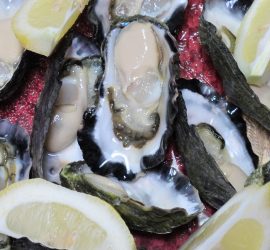Walu

Walu, or Spanish Mackerel, are revered in Fiji and take pride of place on the table. They are voracious pelagic hunters, streamlined, fast and beautiful, exciting fighters on a fishing line and a huge challenge to spear. Fish are silvery grey with narrow vertical bands along their body, and have a formidable set of sharp teeth that they will use very effectively on the unwary. They grow big and can tip the scales at over 110 pounds. The spearfishing record is 100 pounds. A very popular gamefishing target, they are caught mostly by trolling inshore and are around all year, but July through August are usually the best months to catch them.
The Pacific Spanish Mackerel (Scomberomorus commerson), should not be confused with the Atlantic Spanish Mackerel (Scomberomorus maculatus), which is also highly prized for its flavour but is smaller and has spotted markings. Nor should it be confused with the escolar (Lepidocybium flavobrunneum), which is also known as walu and has a reputation for causing gastrointestinal symptoms. Although extremely rare, large Walu have been associated with ciguatera poisoning in parts of Australia for brief periods.
Mackerel is used in a great many Fijian recipes, and features in the traditional favourites Kokonda and Ika Vokololo.
Pakapaka

Pakapaka, also known as crimson jobfish, deepwater red snapper, pink snapper, and opakapaka in Hawaii, is a delicacy served in only the best restaurants. Pakapaka belong to the large family of fish Lutjanidae, which includes many other very highly regarded food species such as red, black, vermillion, goldband, ruby, queen and flame snapper, red emperor, jobfish, sweetlips, and mangrove jack. Pakapaka is found throughout the Pacific and is very popular in Hawaii where it is considered by many to be the best eating fish available, and grows to a very large size of up to 18 pounds.
Pakapaka has clear flesh with shades of pink and a delicate flavour. It is commonly baked or poached and served whole, although it can be prepared in many different ways including as sashimi. It has a long shelf life and it is caught year-round by commercial and recreational fishermen, and is often pursued by fishing charters taking tourists out to catch the evening meal of perfect fresh fish.
Until recently stocks of deepwater snapper have been protected from overfishing by their distance from large populations of traditional fishermen. However, technology and demand have combined to present a very real threat to many species of the Lutjanidae family worldwide. There are still sustainable pakapaka fisheries in Fiji, and government and industry bodies are beginning to understand how to manage and preserve them. Consumer decisions about eating any species from this family of fish should be very much based on where the fish comes from. Pakapaka is mostly caught by hook and line, usually the least destructive fishing method.
Mahi-mahi

Mahi-mahi are a truly beautiful looking fish treasured for their flavour and for their appeal to sportfishing. Also known as Dorado and Dolphinfish. they have a distinctive shape with a long blunt forehead, a streamlined body adorned by an impressive dorsal fin that extends like a sail along the whole body, and a long forked tail. Their colouring is simply stunning. The Mahi-mahi’s entire body is illuminated by bright and complex mixtures of blue, green, and yellow that constantly change. To the sheer delight of sportsfishermen, it performs remarkable aerial acrobatic feats on the end of a line, leaping metres out of the sea, twisting and dancing on its tail. It is no surprise that the favourite food of mahi-mahi is flying fish!
Mahi-mahi are one of the fastest fish in the sea, reaching speeds of over 50 miles an hour, and also one of the fastest-growing fish in the sea,reaching sexual maturity at around a year and then spawning often. They live for no longer than five years and in that time they can reach a length of six feet and weigh over 80 pounds. They thrive in warm seas across the world, and stocks are very healthy due to their rapid reproduction and highly migratory pelagic lifestyle. Mahi-mahi are caught by trolling or longlining and although these fishing practices do not result in habitat destruction, longlining results in a high rate of bycatch and entanglements of endangered species including sharks, seabirds, turtles and marine mammals.
Mahi-mahi has firm, lean, white flesh with large flakes and a mild sweet flavour. It is suitable for any type of cooking and is commonly served fried, grilled or barbequed.

